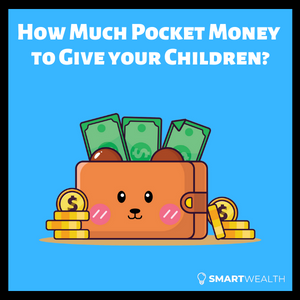Do you remember how much pocket money you received from your parents when you were in school?
Back in our day, it was common to receive between $2 – $10 per day. However, that was when you could still get a full meal at $2, and maybe even a nice ice cream cone from McDonalds at $0.25!
Fast forward to the present, there is no doubt that times have changed immensely, and the price of food, travel expenses and school supplies have risen. What used to be your daily allowance may not suffice for your child today.
At the same time, it is prudent not to overestimate the allowance they require – I’m sure you’ve seen primary school kids having $9 fancy frappuccinos at Starbucks with their friends.
The amount of pocket money you give to your child will be a big factor in helping them to learn the value of money and train them to become financially literate, setting them up for success in life.
This article will give you some tips and tricks on how to decide the amount of daily allowance to give to your child at the different stages of their life – from primary school all the way to university.
3 Important Factors for Consideration
SIDE NOTE When was the last time you conducted thorough financial planning or reviewed your finances? In this day and age in Singapore, doing so will absolutely improve the quality of life for you and your loved ones. Here are 5 reasons why financial planning is so important.
1. What is the pocket money for?
Before deciding on the amount, it is important to consider what the pocket money will be used for. Some parents assign the allowance purely for the child’s food expenses and their other wants and needs.
Others give their child more responsibilities by getting them to use their allowance for their food, transport expenses, school supplies etc.
It doesn’t have to be an all or nothing approach. For a start, it might be good just to help your child with purely controlling their expenses for food, and learning how to save for their wants (e.g. a new toy/ new clothes). As they grow older, more responsibilities can be released to them to help them learn more about the different expenses and how to parcel it out.
2. What is the estimated cost of living at their different stages in life?
Being able to answer this question will require you to do some research. This estimated cost of living is focused purely on their expenses surrounding their schooling life. It will be good to take a trip down to their school canteen with them, and have a quick look at the average meal prices. This can vary greatly from school to school.
Secondly, it is also important to consider the amount of time they will spend in school. If they have to stay back for CCA or after-school activities, you will need to cater for extra meals or snacks.
Lastly, if you would like them to also pay for school supplies, such as stationary and notes, it would be good to take a trip down to Popular with them to estimate the cost and let them know the total budget for stationary and notes.
3. How will they travel to and from school?
Last but not least, travelling to and from school can also be a costly affair. If you would like them to learn to travel independently, it is important to research how much it will cost (even with the subsidy), and decide if you would like them to top up their EZ-Link cards on their own, or if it would be “GIRO-ed” into their account.
Teaching Financial Literacy Through Allowance
The weekly or monthly pocket allowance is a great tool to teach financial literacy to your children. To do it successfully, you will need to have a good balance between catering just enough for what they need, and leaving a little bit more to allow them to build up their own savings to purchase things they want.
As parents, this means also having clarity on whether the following are wants or needs:
- Toys
- Drinks
- Clothes
- Devices
Your answers to these questions will also likely change as they grow. For example, we may buy toys quite freely for our children in their preschool years. However, in primary school, would you consider that slime a want or a need for your child? If you answered “want” – then that is a perfect opportunity for you to educate your child on how much the slime costs, how to save for it, and to buy it with their own savings!
Likewise, a smartphone may be considered a need in these times. However, would you consider the newest iPhone as a want or a need? Having certain clear boundaries on how much you are willing to spend on a phone for your child will help you to decide if it is a want or a need. At 12, your child probably doesn’t need the fanciest phone in the market. He or she could easily get by with a $0 phone (with plan). If they want an iPhone, that can thus be something you teach them to save up for.
DID YOU KNOW? According to a survey conducted by MoneySense, about 3 out of 10 Singapore residents aged 30 to 59 had not started planning for their future financial needs. This isn't surprising because personal finance can seem complicated and daunting. But really, there are only a few things that you should focus on. Learn how to significantly improve your personal finances with the 7-step "wedding cake" strategy today.
Estimated Cost of Living at Each Stage
With all that made clear, here’s the estimated cost of living at their different stages of life. These are estimates, and while they can give you a good ballpark figure, it would be best to look at your own child’s needs and to plan from there. In the figures below, monthly transport allowance is not included – from primary school to university years, it may be more helpful to put in money in their ez-link card for travel. This reduces the likelihood of them taking private hire cars or taxis – unless they are willing to use what is designated for their food to do so!
Primary School
| Estimated Cost for Food alone | Recommended Monthly Allowance | |
| Primary 1 to 3 | $1.50-$1.80/meal – one meal a day in school | $1.70 x 20 days = $34 (+ 6 for savings) = $40 |
| Primary 4 to 6 | $1.50-$1.80/meal – one meal a day in school, except for CCA days (2x a week) which may require 2 meals | ($1.70 x 20 days) + ($1.70 x 8 days) = $48.Recommend $50 for monthly allowance |
Secondary School
| Estimated Cost for Food Alone | Recommended Monthly Allowance | |
| Sec 1 to 4/5 | $2-3/meal – two meals a day in school | $2.50 x 20 days = $50 + $10 for savings= $60 |
Junior College
| Estimated Cost for Food Alone | Recommended Monthly Allowance | |
| JC1 and JC2 | $3-5/meal – two meals a day in school | $4 x 20 days = $80 + $10 for savings= $90 |
Polytechnic, ITE and University
| Estimated Cost for Food Alone | Recommended Monthly Allowance | |
| Polytechnic, ITE and University | $4-6/meal – two meals a day in school | $5 x 20 days = $100 + $10 for savings= $110 |
Conclusion
It is good to start researching, and also to decide with your spouse what sort of values you would like to teach your children about money, and the importance of saving.
Having a good plan can be a determining factor about how well your child is able to manage money responsibly, and set them up for life as they learn to budget for more needs as they grow.


